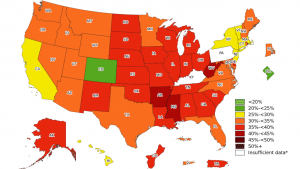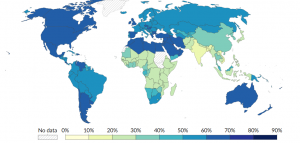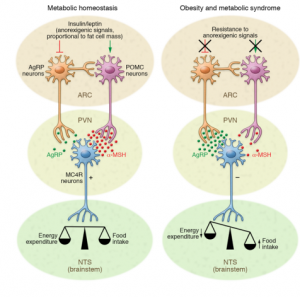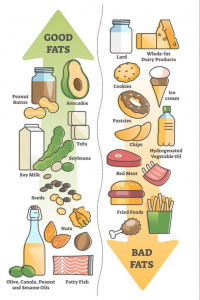Obesity is common in the United States, with more than 1 in 5 people in the United States being obese. [1] The figure below represents that some areas of the U.S., such as the Midwest and the South, have even higher rates of obesity.


What’s Happening in the Body During Obesity
The hypothalamus, a region in the brain, is responsible for our appetite and eating behaviors. There are AgRP neurons and POMC neurons inside the hypothalamus. The AgRP neuron signals tells us we’re not full, while POMC neuronal signals tells us we’re full. The yellow AgRP neurons will activate the blue MC4R neurons, the “eat” neurons so we keep eating, while the POMC neurons will inhibit the MC4R. In other words, the POMC will make sure the “eat” neuron, the MC4R neurons, will stop telling us to eat.

Impact of a High Fat Diet on our Bodily Processes
Obesity also causes low-grade inflammation throughout the body that can disrupt important processes, including neurons such as AgRP and POMC. Some of this inflammation can arise from a high fat diet, even within a few days after a high fat diet. This diet can cause acute inflammation in the hypothalamus. [5] Chronic consumption of a high fat diet will perpetuate the inability to feel full when you’re supposed to.
A high fat diet is when 30-60% of calories consumed are from unsaturated and saturated fats. [6]

A Reflection on Common U.S. Foods
Considering that foods that are high in saturated fats such as fried food, red meat, chips, vegetable oil, and dairy products are in the everyday diet for a lot of Americans, it’s no wonder the obesity rate is so high in the U.S. compared to other countries. Especially considering our large portion sizes that encourage over-eating.
Food is not the enemy, neither is saturated fats in low amounts, but it’s important to have balance in our diets to ensure a healthy life. A hamburger and fries won’t completely harm your body, but it’s beneficial to limit the consumption of these “bad” foods and balance it with healthy foods.
References
[1,2] CDC. (2024, September 12) Adult Obesity Prevalence Maps. https://www.cdc.gov/obesity/data-and-statistics/adult-obesity-prevalence-maps.html
[3] Ritchie, H., Roser, M. (2017, August) Obesity. Our World in Data. https://ourworldindata.org/obesity
[4,5] Jais, A., Brüning, J. C., (2017). Hypothalamic inflammation in obesity
and metabolic disease. The Journal of Clinical Investigation, Vol. 127(1): 24-32. doi:10.1172/JCI88878.
[6] Willebrords, J, et. al. (2015). Strategies, models and biomarkers in experimental non-alcoholic fatty liver disease research. Progress in Lipids Research, Vol. 59: 106-125. https://doi.org/10.1016/j.plipres.2015.05.002
[7] YMCA. (2022, June 1). Four Myths About Eating Fats. https://lafayettefamilyymca.org/myths-about-eating-fats-2/
[8] Jais, A., Brüning, J. C., (2017). Hypothalamic inflammation in obesity
and metabolic disease. The Journal of Clinical Investigation, Vol. 127(1): 24-32. doi:10.1172/JCI88878.
